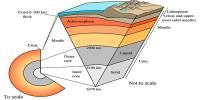According to research presented at the 2023 Annual Meeting of the Seismological Society of America (SSA), faults in the Ridgecrest, California region were extremely susceptible to solid earth tidal stresses in the year and a half prior to the July 2019 Ridgecrest earthquake sequence.
“The signal of tidal modulation becomes extremely strong” after 2018, said Eric Beauce of Lamont-Doherty Earth Observatory, who noted that the signal was identified with seismicity that occurred around the faults that broke in the 2019 magnitude 7.1 earthquake.
The connection does not, however, imply that the earthquake was caused by tidal stresses, which are negligibly minor in comparison to other tectonic stressors.
“We don’t know if something started to happen in the fault zone, something that is an indicator of the upcoming earthquake,” Beauce said. “Maybe that process changed the properties of the crust in a way that made the crust be more sensitive to tidal stresses.”
The solid earth experiences periodic deformation due to the same gravitational pull of the sun and moon that causes ocean tides. Although the ground deforms between 10 and 20 millimeters every day, people cannot feel the changes.
As we do not know if we are looking at a general phenomenon or one specific to the Ridgecrest earthquake only. But I see it as a way of getting new observational constraints on the physics of earthquakes, possibly the preparation and nucleation of earthquakes.
Eric Beauce
These solid tides “induce very, very small stress changes in the crust,” Beauce explains, “which can induce stress changes in all the faults within the crust.”
Despite the fact that these minute stress variations have been known to scientists for more than a century, it has proven challenging to extract their signal from the seismic record and determine if they modulate seismicity.
“In the past ten years, however, better earthquake detection and analysis techniques have made it possible to search through earthquake catalogs to find the signal of tidal stresses,” Beauce said.
Using machine learning algorithms and other methods, he and his colleagues created an extensive, high-resolution earthquake catalog for the region of Ridgecrest’s microseismicity over the last ten years. (Microseismicity usually refers to earthquakes of magnitude 2.0 or smaller).
They found that “there is suggestive evidence that peak seismicity happens when tidal stresses are maximum,” Beauce said, “but this modulation is weak, and because it is weak, it is only suggested.”
According to Beauce, decades before to the earthquakes, other researchers studying the 2004 Indian Ocean and 2011 Tohoku megathrust earthquakes found an increase in seismicity modulation linked to tidal forces. Additionally, some scientists have been successful in producing comparable outcomes in laboratory earthquake studies.
The tidal findings do not have direct implications for earthquake forecasting, “as we do not know if we are looking at a general phenomenon or one specific to the Ridgecrest earthquake only,” said Beauce, “but I see it as a way of getting new observational constraints on the physics of earthquakes, possibly the preparation and nucleation of earthquakes.”
















